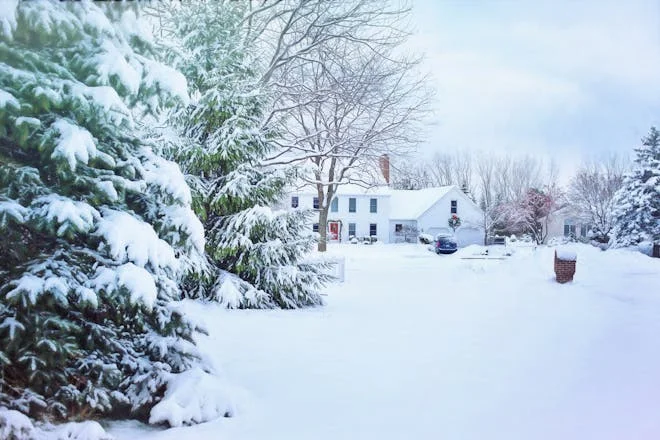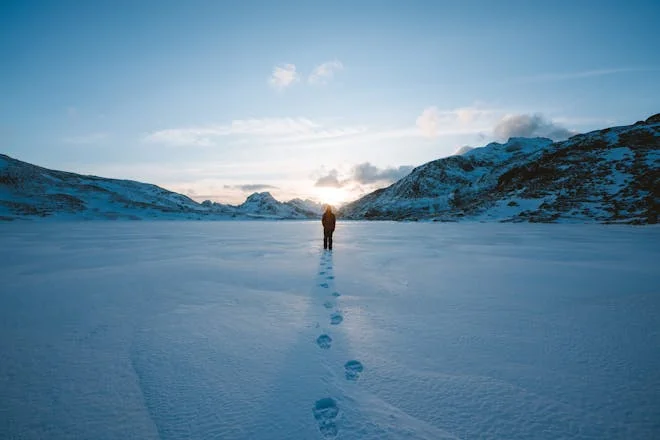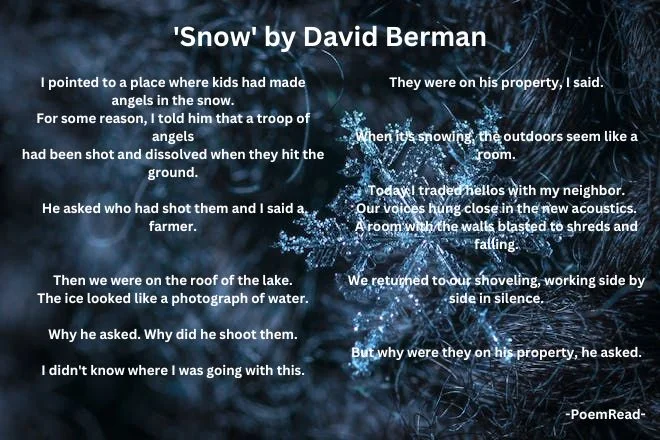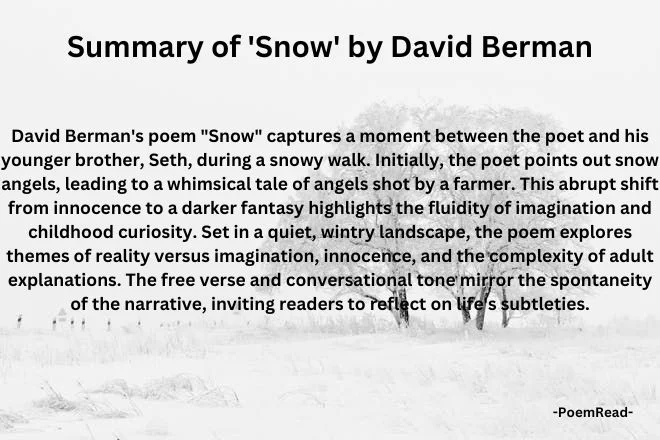
David Berman’s poem “Snow” beautifully combines simplicity with deep meaning, exploring the subtleties of childhood innocence and adult understanding. In this article, we will provide a detailed analysis of “Snow,” examining its themes, context, and literary devices. By breaking down the poem line by line, we will reveal the layers of meaning in Berman’s work.
Join us as we explore how a simple moment between siblings in a snowy field can become a significant reflection on life’s complex questions. Whether you are new to Berman’s poetry or a longtime fan, this analysis will offer new insights into the lasting appeal of “Snow.”
Snow
I pointed to a place where kids had made angels in the snow.
For some reason, I told him that a troop of angels
had been shot and dissolved when they hit the ground.
He asked who had shot them and I said a farmer.
Then we were on the roof of the lake.
The ice looked like a photograph of water.
Why he asked. Why did he shoot them.
I didn't know where I was going with this.
They were on his property, I said.
When it's snowing, the outdoors seem like a room.
Today I traded hellos with my neighbor.
Our voices hung close in the new acoustics.
A room with the walls blasted to shreds and falling.
We returned to our shoveling, working side by side in silence.
But why were they on his property, he asked.
Content
- About the Author
- Subject of 'Snow' by David Berman
- Context of 'Snow' by David Berman
- Theme and Tone of 'Snow' by David Berman
- Form and Structure of 'Snow' by David Berman
- Persona, Setting, and Narration of 'Snow' by David Berman
- Line-by-Line Analysis of 'Snow' by David Berman
- Poetic and Literary Devices Used in 'Snow' by David Berman
- Implications and Meanings of 'Snow' by David Berman
- Interactive Summary
About the Author
David Berman was an American poet, singer-songwriter, and founder of the band Silver Jews. Berman, who was born in 1967 in Williamsburg, Virginia, became well-known for his literary works thanks to his acute observational abilities and comprehensive understanding of human emotions.
His work often reflects themes of isolation, the search for meaning, and the complexities of human relationships. Berman’s tragic death in 2019 left a significant void in the world of contemporary poetry and music, but his legacy continues through his poignant and evocative works.
Subject of ‘Snow’ by David Berman
“Snow” by David Berman captures a moment shared between the poet and his younger brother, Seth, during a walk in a snowy field. Initially, the poet points out snow angels to Seth, sparking a whimsical story about a troop of angels being shot by a farmer. This sudden shift from reality to fantasy highlights the fluid nature of imagination and how children easily accept fantastical ideas.
Seth’s repeated questions about the farmer’s actions add depth, emphasizing the innocence of childhood and the often-mysterious nature of adult explanations. Ultimately, the subject of the poem is not just the walk in the snow, but also the bond between siblings and how stories shape our understanding of the world.
Context of ‘Snow’ by David Berman
“Snow” is set in a quiet, wintry landscape, providing a reflective backdrop for the poet’s thoughts. The serene, isolating atmosphere of a snowy day enhances the contemplative mood. Written in the late 20th century, the poem reflects postmodernist tendencies by blending everyday reality with fantastical elements.
The conversational tone and spontaneous narrative blur the lines between different realities, a common trait in postmodern literature. This setting allows for the exploration of themes like isolation, the search for meaning, and the balance between imagination and reality. The snow-covered environment, with its stillness and quiet, becomes a metaphorical space for introspection. This context emphasizes the poem’s reflective tone and highlights themes of innocence and existential wonder.
Theme and Tone of ‘Snow’ by David Berman
Theme
The main theme of “Snow” by David Berman is the interplay between reality and imagination. The poet turns an ordinary scene into a surreal story through the act of storytelling, showing how easily our perceptions can change. This theme is enriched by exploring childhood innocence and the complexity of adult explanations.
The conversation between the poet and his younger brother, Seth, highlights children’s natural curiosity and their willingness to accept imaginative stories as true. Additionally, the poem addresses themes of isolation and connection. The snowy setting creates a backdrop for introspection and solitude. At the same time, the interaction between the brothers and the poet’s exchange with his neighbor emphasize the human need for connection and understanding.
Tone
The tone of “Snow” is contemplative and reflective, with an underlying sense of melancholy. Berman’s narrative style is conversational yet introspective, inviting readers to consider the deeper meanings behind his words. The whimsical and surreal elements add a touch of absurdity and dark humor, contrasting with the serious undertones.
The reflective nature of the poem is enhanced by the serene, wintry setting, which evokes quiet contemplation. The dialogue between the poet and his brother adds innocence and wonder, while the interactions with the neighbor introduce a sense of communal connection amid the solitude. Overall, the tone captures the complexity of human emotions, balancing childlike curiosity with adult reflection.
Form and Structure of ‘Snow’ by David Berman
Structure
“Snow” by David Berman is written in free verse, which means it does not follow a specific rhyme scheme or metrical pattern. This choice gives the poem a natural, conversational flow, mirroring the spontaneous and organic nature of the dialogue between the poet and his brother. The poem is divided into three stanzas of varying lengths:
- First Stanza: 5 lines
- Second Stanza: 3 lines
- Third Stanza: 5 lines
The irregular stanza lengths contribute to the poem’s organic feel and reflect the fluidity of the narrative.
Pauses and Line Breaks
Berman’s use of pauses and line breaks is deliberate and meaningful. These breaks often signify moments of thought and reflection, allowing readers to pause and absorb the narrative’s emotional weight. The line breaks also highlight key phrases and questions, drawing attention to the poem’s central themes. For example, the break after “I didn’t know where I was going with this” emphasizes the poet’s uncertainty and the spontaneous nature of the storytelling.
Punctuation and Rhyme
The poem features minimal punctuation, which enhances its conversational tone and fluidity. The absence of a consistent rhyme scheme contributes to the free verse structure, allowing the poem to flow naturally without the constraints of a formal pattern. This choice supports the theme of blending reality with imagination, as it mirrors the unpredictability and spontaneity of the poet’s narrative.
Meter
Although “Snow” is free verse, it still contains rhythmic elements that contribute to its natural flow. Berman uses varying line lengths and natural speech patterns to create an engaging rhythm. The lack of a strict meter allows the poem to shift in pace, reflecting the dynamic conversation between the poet and his brother.
For instance, the line “The ice looked like a photograph of water” has a flowing, almost lyrical quality, while “Why he asked. Why did he shoot them” uses shorter, more abrupt phrases to capture the immediacy of the brother’s curiosity.
Persona, Setting, and Narration of ‘Snow’ by David Berman

Persona
The persona in “Snow” by David Berman is the poet himself. He assumes a reflective and introspective voice. This voice is contemplative, moving between whimsical imagination and deeper reflection. The poet speaks in a conversational and intimate way, inviting readers into a personal dialogue.
Through his interaction with his younger brother, Seth, the persona blends childlike curiosity with adult introspection. This mix allows the poet to explore complex themes through a simple narrative, creating a layered and engaging voice.
Setting
The setting of “Snow” is a serene, wintry landscape that plays a crucial role in the poem’s mood and themes. The poem starts with the brothers walking through a snow-covered field, evoking tranquility and isolation. The mention of snow angels adds a touch of whimsy, contrasting with the stark winter scene.
As the story progresses, the setting shifts to a frozen lake, described as “the roof of the lake,” where the ice looks like a “photograph of water.” This imagery blurs the line between reality and imagination. The quiet, still winter environment provides a backdrop for introspection and contemplation. Additionally, the interaction with the neighbor during shoveling introduces a sense of community, contrasting with the overall solitude of the snowy landscape.
Narration
The narration in “Snow” is first-person, giving a direct and intimate look into the poet’s thoughts and experiences. This perspective allows readers to closely engage with the poet’s internal dialogue and the spontaneous storytelling shared with his brother. The narrative unfolds through observations and conversations, blending the ordinary with the fantastical.
The poet’s story about angels shot by a farmer introduces surreal elements, while the brother’s persistent questions drive the narrative forward. The use of dialogue enhances realism, capturing the innocence of childhood curiosity and the fluid nature of imaginative play.
The poet’s reflective asides, like “I didn’t know where I was going with this,” add depth, showing his awareness of the story’s spontaneous nature. Overall, the narration in “Snow” balances conversational dialogue with introspective reflection, creating a rich narrative that invites readers to explore the complexities of imagination and reality.
Line-by-Line Analysis of ‘Snow’ by David Berman
In “Snow,” David Berman crafts a layered narrative that moves between the innocence of childhood and the complexities of adult understanding. Through the use of contrasting imagery and thought-provoking dialogue, Berman invites readers to reflect on the themes of innocence, violence, property, and the transient nature of life’s moments. The poem’s free verse form and lack of consistent rhyme or punctuation underscore the fluidity of its ideas and the open-ended nature of its interpretation.
“Walking through a field with my little brother Seth”
This opening line sets the scene and introduces the characters. The casual tone and simple language immediately create a sense of intimacy and informality. The use of “walking” conveys a leisurely, reflective activity, suggesting a moment of peace and connection between the poet and his brother. The mention of “my little brother Seth” personalizes the poem, indicating a familial bond that will be central to the narrative.
“I pointed to a place where kids had made angels in the snow.”
The poet points out snow angels, introducing a whimsical, childlike element. The phrase “kids had made” evokes innocence and playfulness, setting a contrast with the more surreal and darker elements that will follow. The snow angels symbolize purity and joy, common themes associated with snow. Furthermore, the act of pointing to the angels suggests a desire to share and preserve this moment of purity.
“For some reason, I told him that a troop of angels”, “had been shot and dissolved when they hit the ground.”
This sudden shift from reality to fantasy introduces a surreal and dark narrative. The phrase “for some reason” implies spontaneity and perhaps a lack of forethought, hinting at the poet’s playful yet careless storytelling. The image of angels being shot and dissolving contrasts sharply with the earlier innocence, introducing a sense of violence and mystery. This could also symbolize the loss of innocence or the harsh truths that often shatter childhood beliefs. This juxtaposition highlights the fluidity of imagination and the unpredictable nature of stories.
“He asked who had shot them and I said a farmer.”
Seth’s curiosity drives the narrative forward, reflecting the natural inquisitiveness of children. The poet’s response, “a farmer,” adds a mundane yet absurd twist to the story. The farmer, a figure typically associated with nurturing and growth, is paradoxically cast as the perpetrator of violence. Additionally, the speaker’s response, blaming a farmer, could represent the intrusion of reality and adult concerns into the child’s world. This contrast underscores the poem’s theme of blending the ordinary with the fantastical.
“Then we were on the roof of the lake,”” The ice looked like a photograph of water.”
The setting shifts to a frozen lake, described in a metaphorical and visually striking way. “The roof of the lake” implies a surreal, elevated perspective, reinforcing the blurring of reality and imagination. The comparison of the ice to a “photograph of water” suggests stillness and clarity, capturing a moment frozen in time. This imagery enhances the poem’s contemplative and introspective tone.
“Why he asked.”” Why did he shoot them.”
Seth’s persistent questioning emphasizes his innocence and desire for understanding. The repetition of “why” highlights his confusion and the need for a logical explanation in a seemingly illogical narrative. This line also reflects the broader human quest for meaning in a world often filled with inexplicable events.
“I didn’t know where I was going with this.”
The poet’s admission of uncertainty reveals the spontaneous nature of his storytelling. This line adds a meta-narrative element, as the poet reflects on the act of creating the story itself. It underscores the theme of imagination’s unpredictability and the often-aimless nature of creative thought.
“They were on his property, I said.” “They were on his property, I said.”
The poet offers a simplistic explanation, attempting to justify the farmer’s actions. The idea of “property” introduces themes of ownership and boundaries, suggesting a possible reason for the violence. This line reflects how adults often provide unsatisfactory or simplistic answers to complex questions. This line also raises questions about the rights of individuals versus the freedom of others, even in a metaphorical sense.
“When it’s snowing, the outdoors seem like a room.”
This line shifts to a more reflective and metaphorical tone, drawing a comparison between the outdoors and a room. Snow, with its muffling effect and blanketing presence, creates an enclosed, intimate space. This metaphor emphasizes the transformative power of snow and its ability to alter perceptions of space and reality.
“Today I traded hellos with my neighbor,” ” Our voices hung close in the new acoustics.”
The narrative momentarily shifts to a mundane interaction with a neighbor. The phrase “traded hellos” suggests a brief, casual exchange, while “our voices hung close” evokes a sense of intimacy and connection. The “new acoustics” created by the snow further highlight the theme of transformation and the altered perceptions that snow brings.
“A room with the walls blasted to shreds and falling.”
This line juxtaposes the earlier metaphor of snow as a room with a more violent, chaotic image. The “walls blasted to shreds” suggests destruction and disintegration, contrasting with the serene, enclosed space created by snow. This contrast reinforces the theme of duality and the coexistence of peace and chaos in the world. It also contrasts with the earlier sense of intimacy, suggesting that the barriers we build can be easily torn down.
“We returned to our shoveling,” ” working side by side in silence.”
The poet and the neighbor return to their mundane task, shoveling snow. The phrase “working side by side in silence” emphasizes a sense of quiet companionship and shared labor. This line reflects the human capacity for cooperation and connection even in routine activities, emphasizing the theme of communal bonds. Additionally, the silence shared between the neighbors implies a shared understanding or a mutual respect for the gravity of the moment.
“But why were they on his property, he asked.”
Seth’s final question circles back to the earlier narrative, highlighting his persistent curiosity and the need for closure. This line brings the focus back to the surreal story of the angels, emphasizing the unresolved nature of the narrative. It reflects the broader theme of seeking answers and understanding in a complex, often inexplicable world. Consequently, it shows the human need for reason and the discomfort we feel when faced with senseless acts.
Poetic and Literary Devices Used in ‘Snow’ by David Berman

Imagery
Berman employs vivid imagery throughout the poem to create a sensory experience for readers. For instance, when he describes “kids had made angels in the snow,” readers can visualize the playful and innocent scene of snow angels created by children. This imagery evokes a sense of nostalgia and childhood wonder, setting the tone for the poem.
Similarly, when Berman writes, “The ice looked like a photograph of water,” he paints a clear picture of the frozen lake, using visual imagery that captures the stillness and clarity of the ice’s appearance.
Metaphor
Metaphors serve as potent tools in David Berman’s “Snow,” enriching the poem with layered meanings and evocative imagery. Through these comparisons, complex emotions and themes are illuminated:
The Snow as Angels: The snow angels in the poem are metaphorical representations of innocence and purity. When the speaker introduces the idea of angels being shot, it extends the metaphor to suggest the vulnerability of innocence in the face of harsh realities.
The Outdoors as a Room: Berman’s metaphor of the outdoors resembling a room during snowfall creates a feeling of intimacy and enclosure. This comparison redefines spatial perception, highlighting the transformative power of snow on the environment’s acoustics and ambiance.
The Ice as a Photograph of Water: Describing the ice on the lake as a “photograph of water” metaphorically captures the stillness and preserved nature of the frozen moment. This metaphor also hints at the concept of appearance versus reality, as the ice is a static representation of water’s dynamic nature.
The Snow as Walls Blasted to Shreds: Towards the poem’s end, the falling snow is metaphorically depicted as walls being “blasted to shreds.” This vivid imagery symbolizes disintegration and the breaking down of barriers, potentially representing the collapse of constructed narratives or the inevitability of change.
Berman’s adept use of metaphors throughout “Snow” adds depth and resonance to the poem, inviting readers to explore themes of innocence, reality, transformation, and impermanence in a more imaginative way.
Symbolism
In “Snow” by David Berman, symbolism runs deep, infusing the poem with nuanced meanings:
Snow Angels: Initially innocent, they symbolize childhood innocence, but their imagined demise reflects the loss of innocence and intrusion of harsh realities.
Snow: It symbolizes purity but also represents coldness in relationships and the innocence of youth, reflecting the transformative power of perception.
The Farmer: Though unseen, the farmer symbolizes external forces disrupting innocence and imposing adult realities.
The Room with Blasted Walls: Symbolizes the fragility of constructs we create, hinting at the inevitability of change over time.
Through these symbols, Berman delves into themes of innocence, reality, and the passage of time, creating resonant narrative rich in personal interpretation.
Irony
Irony adds a layer of complexity to the poem’s narrative. The irony lies in the farmer shooting angels, as farmers are traditionally associated with nurturing life rather than causing harm to celestial beings. This ironic twist challenges conventional expectations and introduces a sense of paradoxical humor and absurdity to the poem.
Personification
In “Snow” by David Berman, personification subtly animates the winter landscape, infusing it with emotion and character. While the poem doesn’t directly personify elements like snow or ice, the surroundings create a vivid backdrop that feels alive. For instance, the snow-covered field, the “roof of the lake,” and the ice resembling a photograph suggest an environment that interacts with the characters and their feelings.
This interaction blurs the line between the natural and human worlds, enhancing the poem’s depth and connecting readers to the setting’s emotive resonance. Overall, Berman’s nuanced use of personification enriches the poem’s thematic complexity and reader engagement.
Dialogue
The use of dialogue between the poet and his brother adds realism and develops character dynamics. Through their conversation, readers gain insight into Seth’s curious nature and the poet’s imaginative storytelling. The dialogue also creates a sense of immediacy and engagement, drawing readers into the narrative as active participants in the conversation.
Enjambment
Enjambment, or the continuation of a sentence without a pause beyond the end of a line, creates a flowing and uninterrupted rhythm in the poem. For example, in the line “They were on his property, I said,” the sentence flows seamlessly into the next line, maintaining the poem’s natural and conversational tone. This enjambment technique enhances the poem’s fluidity and adds a sense of spontaneity to the narrative.
Alliteration, Consonance, and Assonance
David Berman’s “Snow” artfully integrates sound patterns to enrich its themes and imagery.
Alliteration: Berman employs alliteration by repeating initial consonant sounds in nearby words, such as “Walking through a field with my little brother Seth” and “For some reason, I told him that a troop of angels.” These instances create a rhythmic quality and emphasize specific images within the poem.
Consonance: While specific examples of consonance weren’t found, the poem’s overall sound scheme can be analyzed for consonance by considering repeated consonant sounds within or at the end of words. For example, the ‘t’ sound in “photograph of water” or the ‘s’ sound in “voices hung close in the new acoustics” contributes to the poem’s auditory texture.
Assonance: Assonance, the repetition of vowel sounds in close proximity, is evident in lines like “Side by side in silence,” where the ‘i’ sound recurs in “side,” “in,” and “silence.” This repetition creates a sense of unity and continuity, enhancing the poem’s overall harmony.
By skillfully employing these sound devices, Berman enhances the emotional depth and reader engagement in “Snow.” The deliberate crafting of sound adds a layer of sensory experience, inviting readers not only to read but also to hear the poem’s lyrical quality.
Repetition
Repetition is used strategically to emphasize certain phrases and themes in the poem. The repetition of phrases like “Why he asked” serves to highlight Seth’s persistent questioning and the theme of seeking understanding. This repetition creates a rhythmic pattern and reinforces key ideas, enhancing the poem’s thematic coherence and impact.
Diction
The poem’s diction, or word choice, plays a crucial role in shaping its impact and conveying intricate meanings. Take, for instance, phrases like “troop of angels,” which evoke a majestic and mythical image, adding a sense of grandeur to the narrative. This choice of words not only paints a vivid picture but also introduces themes of spirituality and wonder.
Similarly, the phrase “new acoustics” introduces a sensory experience linked to sound, suggesting a shift in perception or environment. This precise diction not only appeals to the reader’s senses but also deepens the thematic exploration of transformation and introspection.
Overall, the careful selection of words enhances the poem’s imagery, themes, and overall aesthetic quality, making it a compelling and emotionally resonant piece of literature.
Implications and Meanings of ‘Snow’ by David Berman
The poem “Snow” by David Berman is a captivating exploration of themes that resonate deeply with readers, inviting various interpretations and implications. Its surreal and open structure allows for personal reflections and connections to broader themes.
Themes of Death, Brotherhood, and Loss of Innocence
One of the poem’s deeper implications lies in its exploration of death, brotherhood, and the loss of innocence. It starts with a playful image of snow angels but quickly shifts to a darker tone as the speaker imagines them being shot. This sudden intrusion of violence reflects the inevitable loss of innocence in the face of life’s realities.
Religious Symbolism
Strong religious symbolism is present, drawing connections to themes from the Book of Genesis such as creation, fall, and brotherhood. The snow angels symbolize purity and innocence akin to the Garden of Eden, while their imagined destruction mirrors the introduction of sin into the world.
Connection to Personal and Societal Contexts
Berman’s personal struggles, including depression and substance abuse, along with his complex relationship with his father, add layers of meaning to the poem. It can be seen as a reflection of Berman’s search for meaning in a world that can feel cold and distant.
The Poem as a Reflection of Human Experience
“Snow” serves as a mirror to the human experience, capturing moments of wonder, confusion, and the quest for understanding that define our lives. Its open-ended nature allows each reader to derive their own insights, yet all are touched by its reflections on life, relationships, and the passage of time.
Reflections and Interpretations
“Snow” symbolizes the stark loss of innocence, prompting reflections on growing up. It juxtaposes snow’s picturesque imagery with darker themes, encouraging contemplation on perception versus reality. The poem blurs boundaries between humans and nature, highlighting interconnectedness. It also explores transformation, the power of storytelling, and existential reflections, inviting readers to delve into life’s complexities and the human condition.
Interactive Summary

“Snow” by David Berman is an exploration of childhood innocence, imagination, and the interplay between reality and fantasy. The poem starts with a whimsical scene of snow angels, transitioning into a darker narrative as the speaker imagines them being shot. This shift reflects the loss of innocence in the face of harsh truths, inviting readers to contemplate the complexities of growing up.
Throughout the poem, Berman weaves religious symbolism, personal struggles, and existential themes. The snow angels symbolize purity and the intrusion of violence mirrors the introduction of sin into the world. Berman’s personal context, including depression and family dynamics, adds depth to the poem, reflecting universal experiences of searching for meaning in a challenging world.
“Snow” serves as a reflection of human experience, blending surreal storytelling with introspection. The open-ended structure invites readers to interpret themes of transformation, storytelling’s power, and interconnectedness. Through vivid imagery and thought-provoking dialogue, Berman captures the essence of childhood wonder, existential questioning, and the complexity of human emotions.
Overall, “Snow” transcends its winter setting to become a timeless exploration of innocence lost, perceptions challenged, and the enduring human quest for understanding. It invites readers to engage in a reflective journey, finding resonance in its universal themes and nuanced storytelling.
If “Snow” has caught your attention, dive into our analysis of “We Real Cool” by Gwendolyn Brooks for an insightful journey into themes like youth, identity, and the contrast of simplicity with deep meanings. Uncover the hidden layers beneath the surface of the poem and discover how it resonates deeply with readers.
RELATED POSTS
View all



